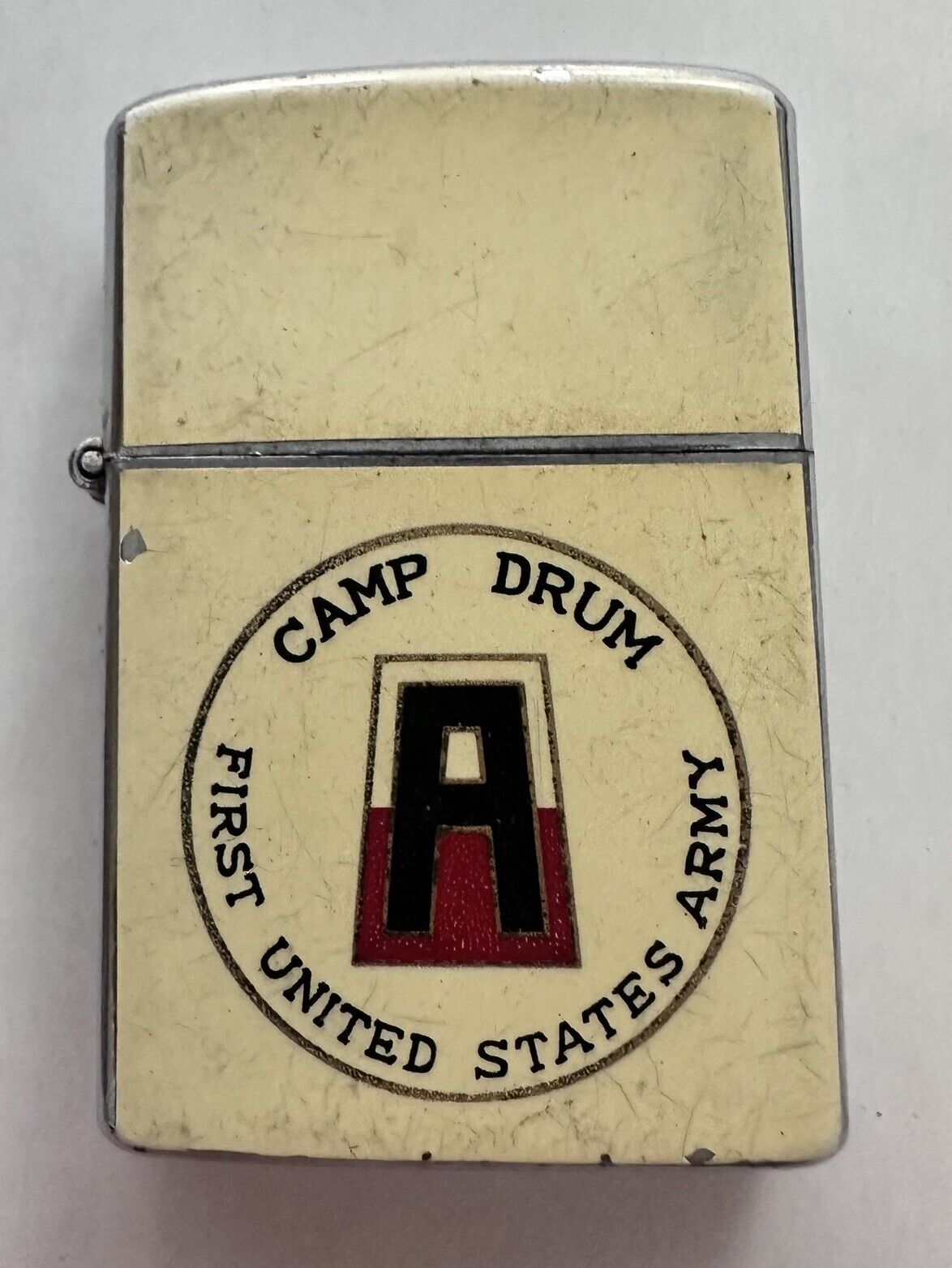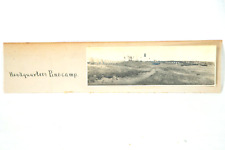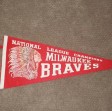When you click on links to various merchants on this site and make a purchase, this can result in this site earning a commission. Affiliate programs and affiliations include, but are not limited to, the eBay Partner Network.
Camp Drum New York
First United States Army
Lighter by
Roger’s Inc.
New York, N.Y.
Made in Japan
Fort Drum is a U.S. Army military reservation and a census-designated place (CDP) in Jefferson County, near the western border of northern New York, United States. The population of the CDP portion of the base was 12,955 at the 2010 census. It is home to the 10th Mountain Division.
Fort Drum
Jefferson County, New York
Near Watertown
1st Battalion, 87th Infantry Regiment, on a run
Area
107,265 acres (434.09 km2)
Site information
Owner
U.S. Army
Controlled by
10th Mountain Division
Built 1908
In use 1908-present
Fort Drum, New York
Census-designated place
Fort Drum is located in New York
United States
State
New York
County Jefferson
Fort Drum consists of 107,265 acres (434.09 km2). In this region, winter temperatures can reach as low as −30 °F (−34 °C). Its mission includes command of active component units assigned to the installation, providing administrative and logistical support to tenant units, support to active and reserve units from all services in training at Fort Drum, and planning and support for the mobilization and training of almost 80,000 troops annually.
A portion of the present Fort Drum was first used as a military training site in 1908 when it was named Pine Camp; the following year land was purchased to develop the camp as an installation. The army had an earlier presence in the North Country from the early 19th century, prior to the War of 1812.
In 1809 the United States stationed a company of infantry soldiers at what was then called Sackett's Harbor to enforce the Embargo Act and control smuggling between northern New York and Canada, particularly Kingston, Ontario. Following the outbreak of the War of 1812, Sacketts Harbor became the center of United States naval and military activity for the Upper St. Lawrence River valley and Lake Ontario. A major shipyard was developed there and twelve warships were completed. The town was rapidly flooded with troops and some 3,000 skilled workers for the navy shipyard, most of whom came from New York City.
During the 1830s and 1840s, the Lower Canada Rebellion in Canada prompted a new round of military preparations. The United States purchased land in Sackets Harbor (as it is now spelled), where it developed Madison Barracks, a base for artillery units.
Pine Camp
In 1908, Major General Frederick Dent Grant was sent to the Pine Camp region to train with 2,000 regulars and 8,000 militia. Grant, the son of Ulysses S. Grant, former United States president and Civil War general, found Pine Plains to be ideal for military exercises. In 1909 the military allocated funds to purchase land to form Pine Camp, and summer training continued here through the years.
The camp came into the national spotlight in 1935, when the largest peacetime maneuvers in American military history up to that point were held on the Pine Plains and surrounding farmland. Approximately 36,500 soldiers came from throughout the Northeast to take part in the exercise. Some soldiers traveled by trains, which arrived in town every 15 minutes, coming from as far away as Buffalo, New York and New York City. For 36 hours, young men from offices, factories, and farms marched, attacked and defended in tactical exercises on the 100 square miles (260 km2) the Army had leased for its war games. The maneuvers were judged to be a success, and the War Department purchased an additional 9,000 acres (3,600 ha) of land.
LeRay Mansion
The LeRay Mansion, built in the early 19th century, was named after James LeRay de Chaumont. Throughout the years the mansion served as a post commander's quarters, visiting dignitaries' quarters and a location for formal military receptions. Today the mansion is used to house high ranking visitors, which has encouraged the continued upkeep of the mansion. The LeRay Mansion is listed on the National Register of Historic Places.[5]
World War II expansion
edit
With the outbreak of World War II in Europe, Pine Camp was selected by the Army for a major expansion. An additional 75,000 acres (30,000 ha) of land was purchased, displacing 525 local families. Five entire villages were eliminated, while others were reduced from one-third to one-half their size. Three thousand buildings, including 24 schools, six churches and a post office, were abandoned.
By Labor Day 1941, 100 tracts of land were taken over. Contractors went to work, and in a period of 10 months at a cost of $20 million, an entire city was built to house the divisions scheduled to train at Pine Camp.
Eight hundred buildings were constructed, including 240 barracks, 84 mess halls, 86 storehouses, 58 warehouses, 27 officers' quarters, 22 headquarters buildings, and 99 recreational buildings, as well as guardhouses and a hospital. Construction workers suffered during this period, as the winter of 1941-42 was one of the coldest in North Country history.
The three divisions to train at Pine Camp included the 4th Armored Division (Gen. Creighton Abrams was a battalion commander there at the time), the 45th Infantry Division (United States), and the 5th Armored Division.
During the war, the post also served as a prisoner of war camp for captured Italian and German troops. Some were allowed to work on area farms during their internment. Of prisoners who died here, one Italian and six Germans are buried in the Sheepfold Cemetery near Remington Pond.
Pine Camp was renamed as Camp Drum in 1951, named after Lieutenant General Hugh A. Drum, who was chief of staff of the First United States Army during World War I and First Army commander at the start of World War II. During and after the Korean War, a number of units were stationed and trained here to take advantage of the terrain and climate.
In 1959, testing of Agent Orange began on more than 1,000 acres (405 ha) of Camp Drum.[6] Several communities at or near Agent Orange manufacturing or storage sites continue to report dioxin levels above recommended safety standards, including Fort Drum. The material was used extensively during the Vietnam War for defoliation.
Renamed Fort Drum and after
In 1974, a permanent garrison was assigned and Camp Drum was renamed Fort Drum. In April 1980, B Company, 76th Engineer Battalion (Combat Heavy) was reassigned from Fort Meade, Maryland. Three years later the rest of the battalion was transferred here, with the exception of D Company.
On 11 September 1984, the announcement was made that Fort Drum would be the new home of the 10th Light Infantry Division. Its mission is to be manned and trained to deploy rapidly by air, sea, and land anywhere in the world, prepared to fight upon arrival and win. The first of the division's troops arrived at Fort Drum on 3 December 1984, and the unit was officially activated on 13 February 1985. The name was changed to the 10th Mountain Division (Light Infantry) at that time. The division reached full strength in 1989.
Between 1986 and 1992, 130 new buildings, 35 miles (56 km) of roads, and 4,272 sets of family quarters were built at a cost of $1.3 billion.
On 4 June 1985, the identity of a roundout brigade was announced that would be composed of Army National Guard battalions. Units from the New York Army National Guard from central and northern New York under the 27th Infantry Brigade made the roundout brigade.
On 28 June 1985, the 76th Engineer Battalion was inactivated.
In 2013 Fort Drum was being considered for the location of a proposed Eastern United States missile defense site.[8]
In 2014, a 60-megawatt biofuel power plant was established to provide energy for the base, part of the U.S. military's push for renewable energy and self-sufficiency.
In 2015, Diana M. Holland was promoted to become the first woman general at Fort Drum, and the first woman to serve as a deputy commanding general in one of the Army's light infantry divisions (specifically, the 10th Mountain Division).
Current units
10th Mountain Division
1st Brigade Combat Team, 10th Mountain Division
2d Brigade Combat Team, 10th Mountain Division
Combat Aviation Brigade, 10th Mountain Division
10th Mountain Division Artillery, 10th Mountain Division
10th Mountain Division Sustainment Brigade
American Red Cross (ARC)
U.S. Army Materiel Command FSC (LAO)
Wheeler-Sack Army Airfield
20th Air Support Operations Squadron (United States Air Force)
Air Force Weather, 20th Air Support Operations Squadron (20th ASOS)
Fort Drum Criminal Investigation Command (CID)
Non-commissioned Officers Academy
Naval Reserve Center - Fort Drum
1st Battalion (Infantry), 314th Regiment; 2d Battalion (Logistics Support), 313th Regiment; and 3d Battalion (Field Artillery), 314th Regiment (all under the 174th Infantry Brigade, previously known as 2d Brigade, 78th Division Training Support, now stationed at Fort Dix)
7th Legal Support Organization (7th LSO)
725th Ordnance Company (EOD)
174th Fighter Wing Air-Ground Gunnery Range
1215th Garrison Support Unit (USAR)
Guthrie Ambulatory Health Care Clinic
U.S. Air Ambulance Detachment
760th Ordnance Company (EOD)
63d Ordnance Battalion (EOD)
91st Military Police Battalion
7th Engineer Battalion
630th Engineer Company (Route Clearance)
642d Engineer Company (Support)
Company B (Field Maintenance), 427th Brigade Support Battalion, 27th Infantry Brigade Combat Team, New York Army National Guard (NYARNG);
1427th Transportation Company (Medium Truck), 53rd Troop Command, NYARNG;
Company C, Recruiting and Retention Command, NYARNG;
Maneuver Area Training Equipment Site (NY MATES), NYARNG.
925th Contracting Battalion
First Army is the oldest and longest-established field army of the United States Army.It served as a theater army, having seen service in both World War I and World War II, and supplied the US army with soldiers and equipment during the Korean War and the Vietnam War under some of the most famous and distinguished officers of the U.S. Army. It now serves as a mobilization, readiness and training command
First Army
Active
10 August 1918 – 20 April 1919
8 September 1932 – present
(91 years, 6 months)
Country
United States
Branch
United States Army
Type
Security operations
Role
Training support
Size
Theater Army
Part of
United States Army Forces Command
Garrison/HQ
Rock Island Arsenal
Rock Island County, Illinois, in Deed
Anniversaries
10 August 1918
Engagements
World War I
World War General
MG William A. Ryan (acting)
Deputy Commanding General (Operations)
BG Jason P Nelson
Deputy Commanding General (Support)
MG Jeffrey W. Jurasek
Command Sergeant Major
CSM Christopher A. J. Pershing
Omar Bradley
Courtney Hodges
Russel L. Honoré
Oliver W. unit insignia
Establishment and World War I
The First Army was established on 10 August 1918 as a field army when sufficient American military manpower had arrived on the Western Front during the final months of World War I. The large number of troops assigned to the American Expeditionary Forces (AEF) required the activation of subordinate commands. To fill this need, First Army was the first of three field armies established under the AEF. The first commander was General John J. Pershing, who also served as Commander-in-Chief (C-in-C) of the AEF. The headquarters planned and directed the first major American offensive, the St Mihiel Offensive (September 12 to 16, 1918). It later went on to fight in the largest and deadliest battle in the United States Army's history, the Meuse–Argonne offensive. Serving in its ranks throughout World War I were many figures who later played important roles in World War II. First Army, now under Lieutenant General Hunter Liggett, was inactivated on April 20, 1919, five months after the Armistice with Germany which ended hostilities.
Inter-war years
As part of an army reorganization and final realization of the 1920 amendment to the National Defense Act of 1916, Army Chief of Staff, General Douglas MacArthur directed the establishment of four field armies that each commanded three corps areas that were geographically located. The field armies were established to provide an organizational structure for large military organizations that might be mobilized in times of national need.
First Army was located in the northeast United States and was activated on 11 September 1933 at Fort Jay, Governors Island, New York. Initially activated as a paper army, it was commanded by General Dennis E. Nolan. Until 1942, First Army's commander was always the senior commander of one of its three corps areas. The First Corps Area was headquartered in Boston, Massachusetts, Second Corps Area was headquartered at Fort Jay, Governors Island, in New York, New York, and Third Corps Area was located at Fort Howard (Maryland) near Baltimore, Maryland. Since First Army was only a paper organization in its early days, its staff was the existing staff of the corps areas. The overall mission of the First Army was commanding and training the regular army, army reserve and national guard units in the three corps areas.
Nolan, the American Expeditionary Force's (AEF) chief of intelligence during World War I, commanded First Army from 1933 to 1936. He was followed by Major General Fox Conner, previously First Corps Area commander, who had been the AEF's Chief of Operations in World War I. In the years between the wars, Conner was a crucial mentor in the careers of Dwight Eisenhower and George C. Marshall. Passed over as a candidate for Army Chief of Staff for Douglas MacArthur in 1930, Conner was assigned to command the First Corps Area instead, later commanding First Army in 1936. Conner retired in 1938.
In 1938 First Army came under command of General Hugh A. Drum. Drum, who along with a buildup of the Army in 1939 and through the early 1940s, began to develop the First Army into a bona fide field army. It began to establish and develop its own staff and participated in the large-scale Army maneuvers in Louisiana and North Carolina between 1939 and 1941. As the United States entered World War II, Drum was assigned command of the newly established Eastern Defense Command, responsible for coastal and domestic defense, which relieved the First Army of this responsibility on 24 December 1942. Drum retired in 1943 when he reached mandatory retirement age. General George Grunert, commander of Second Service Command, assumed command of the First Army until Headquarters, First Army was activated in Bristol, England in January 1944 under command of General Omar Bradley.
World War II
First Army's entry into World War II began in October 1943 as Bradley returned to Washington, D.C., to receive his command and began to assemble a staff and headquarters to prepare for Operation Overlord, the codename assigned to the establishment of a large-scale lodgement on the European Continent following Operation Neptune, which was the invasion of Normandy. The headquarters were activated in January 1944 at Bristol, England.
Upon going ashore on 6 June 1944, D-Day, First Army came under General Bernard Montgomery's 21st Army Group (alongside the British Second Army) which commanded all American ground forces during the invasion. Three American divisions were landed by sea at the western end of the beaches, and two more were landed by air. On Utah Beach, the assault troops of VII Corps made good progress, but V Corps on Omaha Beach came nearest of all of the five landing areas to disaster. The two American airborne divisions that landed, the 82nd and 101st, were scattered all over the landscape, and caused considerable confusion among the German soldiers, as well as largely securing their objectives, albeit with units completely mixed up with each other. First Army captured much of the early gains of the Allied forces in Normandy. Once the beachheads were linked together, its troops struck west and isolated the Cotentin Peninsula, and then captured Cherbourg. When the American Mulberry harbour was wrecked by a storm, Cherbourg became even more vital.
After the capture of Cherbourg, First Army struck south. In Operation Cobra, its forces finally managed to break through the German lines. The newly established Third Army was then fed through the gap and raced across France.
With the arrival of more US troops in France, the Army then passed from the control of the 21st Army Group to the newly arrived 12th Army Group which commanded the First Army and the newly formed Third Army under Lieutenant General George S. Patton. General Bradley assumed command of the 12th Army Group and Lieutenant General Courtney Hodges was placed in command of the First Army. First Army followed Third Army, the American armies forming the southern part of the encirclement of Germans at the Falaise pocket.
After capturing Paris (the Wehrmachtbefehlshaber von Groß-Paris, Dietrich von Choltitz, capitulated 25 August, ignoring Hitler's Trümmerfeldbefehl),[7][8] During the Battle of the Mons Pocket VII Corps took approximately 25,000 prisoners.[9] First Army headed towards the south of the Netherlands. First Army liberated most of Luxembourg in three days from 9–12 September 1944.
When the Germans attacked during the Battle of the Bulge, First Army found itself on the north side of the salient, and thus isolated from 12th Army Group, its commanding authority. It was, therefore, temporarily transferred, along with Ninth Army, back to 21st Army Group under Montgomery on 20 December.[10] The salient was reduced by early February 1945. Following the Battle of the Bulge, the Rhineland Campaign began, and First Army was transferred back to 12th Army Group. In Operation Lumberjack, First Army closed up to the lower Rhine by 5 March, and the higher parts of the river five days later.
On 7 March, in a stroke of luck, Company A, 27th Armored Infantry Battalion, part of Combat Command B, 9th Armored Division, found the Ludendorff Bridge across the Rhine at Remagen still standing. It quickly captured the bridge and established a secure bridgehead. in the next 15 days, over 25,000 troops and their equipment crossed the river. By 4 April, an enormous pocket had been created by First Army and Ninth Army, which contained the German Army Group B under Field Marshal Model, the last significant combat force in the northwest of Germany. While some elements of First Army concentrated on reducing the Ruhr pocket, others headed further east, creating another pocket containing the German Eleventh Army. First Army reached the Elbe by 18 April. There the advance halted, as that was the agreed demarcation zone between the American and Soviet forces. First Army and Soviet forces met on 25 April.
In May 1945, advance elements of First Army headquarters had returned to New York City and were preparing to redeploy to the Pacific theater of the war to prepare for Operation Coronet, the planned second phase of Operation Downfall the proposed invasion of Honshū, the main island of Japan in the spring of 1946, but the Japanese surrender in August 1945 thanks to the atomic bombings of Hiroshima and Nagasaki terminated that effort.
Post-war and peacetime missions
edit
First Army returned to the United States in late 1945; first to Fort Jackson (South Carolina), then to Fort Bragg, North Carolina, returning to Fort Jay, Governors Island, New York, in the spring of 1946. Twenty years later, in 1966, First Army relocated to Fort Meade, Maryland, and took over the responsibilities of Second Army, which was inactivated. In 1973, First Army's mission changed from training and preparation of active units to Army Reserve units. In a 1993 reorganization, five divisions carried out that training and support mission:
75th Division, Houston, Texas
78th "Lightning" Division, Edison, New Jersey
85th "Custer" Division, Arlington Heights, Illinois
87th "Golden Acorn" Division, Birmingham, Alabama
91st "Wild West" Division, Dublin, California
In 1993, Headquarters First Army relocated to Fort Gillem, near Atlanta, Georgia, and became responsible for the training and mobilization of all Army Reserve and National Guard units in the United States and providing assistance to the civilian sector during national emergencies and natural disasters. In the latter role, First Army's contributions during the 2005 Hurricane Katrina disaster was a rare bright spot in leading federal relief efforts in the aftermath of the storm. Its commander, Russel L. Honoré, a Louisiana native, became a nationally recognized figure in his direct, no-nonsense approach to disaster relief which earned First Army a Joint Meritorious Unit Award.
In the 21st century, First Army was subjected to more changes as base closures and force structures were instituted to modernize, economize and change its mission. In 2005, a Base Realignment and Closure (BRAC) Commission decision called for the relocation of First Army headquarters to Rock Island Arsenal, Illinois, in 2011. Its former quarters at Fort Gillem was to transition to a single national location for the mobilization and demobilization of Army National Guard and Reserve units.
In a second change, as part of the 2006 reorganization of the United States Army program, First Army exchanged its civilian assistance mission for the training and support missions for military units in the western United States formerly held by US Fifth Army. Fifth Army then became U.S. Army, North with responsibilities for homeland defense and domestic emergency assistance.
First Army inactivated its training divisions and reactivated them as separate training brigades under two commands. First Army Division East, headquartered at Fort Knox, Kentucky (relocated from Fort Meade, Maryland in 2016), has responsibilities in all states east of the Mississippi River; and First Army Division West assuming Fifth Army's role and relocating from Fort Carson to its new headquarters at Fort Cavazos, Texas, oversees units in all states west of the Mississippi River.
First United States Army was redesignated as First Army on 3 October 2006










